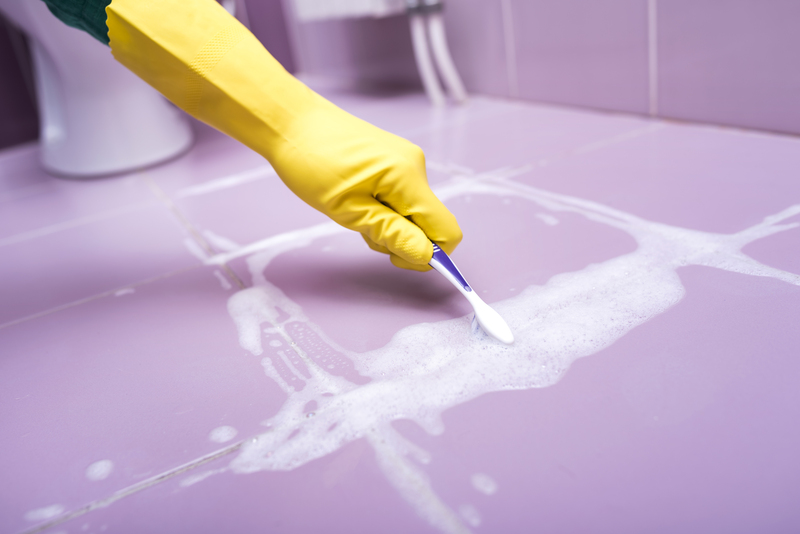Say Farewell to Damp Odor with These Expert Strategies
Posted on 25/09/2025
Say Farewell to Damp Odor with These Expert Strategies
Have you ever entered a room and been greeted by that musty, unpleasant smell that instantly makes your nose wrinkle? Damp odor isn't just an annoyance; it's often a sign of underlying moisture problems that can affect your home's comfort, air quality, and even your health.
In this comprehensive guide, we'll provide expert tips and proven methods to eliminate musty and damp odors from your home. Discover actionable advice on identifying the source, cleaning, dehumidifying, and preventing the problem from returning -- all so you can finally say good-bye to persistent damp smells for good.
Understanding the Source of Damp Odor
Before tackling that bad smell, it's essential to pinpoint why musty damp odors develop in the first place. Typically, they arise due to:
- Excess moisture: Poor ventilation, leaky pipes, or water ingress can leave surfaces damp, providing a perfect breeding ground for odors.
- Mold and mildew: These fungi thrive in humid environments and release volatile organic compounds responsible for the telltale musty smell.
- Neglected cleaning: Forgotten corners, damp fabrics, and closed closets can harbor moisture and odor-causing agents.
To eliminate damp odor efficiently, you must address both the symptoms and the underlying causes. Let's dive into the steps.

Step 1: Detect and Address Moisture Sources
Inspect for Water Intrusion
Begin your journey to a fresher-smelling home by scrutinizing every corner for sources of moisture. Check for:
- Leaky plumbing under sinks, behind appliances, and inside walls.
- Roof leaks, water stains on ceilings, or window condensation.
- Damp basements or crawlspaces prone to flooding or high humidity levels.
- Poor drainage around your foundation that channels rainwater towards your home.
If you find a problem, fix it promptly to prevent odors from returning.
Monitor Humidity Levels
High indoor humidity (over 60%) fuels both musty odors and mold growth. To monitor conditions, invest in a reliable hygrometer.
Ideal indoor humidity should be between 30-50%. If your readings are higher, it's time for a strategy.
Step 2: Deep Clean Problem Areas
Once moisture sources are addressed, focus on cleaning to remove any existing residues that trap bad smells.
Wash and Disinfect Surfaces
- Hard surfaces: Scrub walls, floors, tiles, and grout with a mixture of warm water, white vinegar, and a small amount of baking soda. Vinegar is a natural deodorizer and disinfectant.
- Soft surfaces: Wash curtains, area rugs, upholstery covers, and linens using hot water whenever possible. Dry completely before replacing them.
Don't forget items stored in damp conditions, such as shoes, bags, and stored clothing.
Eliminate Mold and Mildew
Mold not only causes persistent damp odors, but can also exacerbate allergies and respiratory issues. Use specialized mold-killing cleaners or a homemade solution of 1 part hydrogen peroxide to 3 parts water. Spray, let sit for 15 minutes, scrub, and rinse.
For stubborn mold in bathrooms, closets, or on walls, a diluted bleach solution (one cup bleach to one gallon of water) can be effective. Always ventilate well and wear protective equipment.
Step 3: Boost Ventilation and Airflow
Open Doors and Windows
Promote cross-ventilation daily, especially after cleaning or if you notice any hint of that musty smell. If possible, create airflow by opening windows at opposite ends of a room or hallway.
Use Exhaust Fans
- Switch on extractor fans in kitchens, bathrooms, and laundry areas whenever moisture is generated.
- Install additional fans in closets, basements, or attics where airflow is limited.
Consider Air Circulators
Even a simple electric fan can help move stagnant air and accelerate drying in damp areas. For larger spaces such as basements, invest in a high-quality air circulator or box fan.
Step 4: Harness the Power of Dehumidifiers and Natural Absorbers
Invest in a Dehumidifier
When humidity is persistently high, an electric dehumidifier is your best friend. These devices pull moisture from the air and collect it in a reservoir that's easy to empty. Be sure to size the unit appropriately for your space, and:
- Keep doors and windows closed when operating to maximize efficiency.
- Empty the water reservoir daily and clean the filter regularly.
Try Natural Moisture Absorbers
Absorbing agents work well in closets, cupboards, and small rooms. Some popular options include:
- Activated charcoal: Effective at neutralizing odors and absorbing moisture. Place in open containers or breathable bags.
- Baking soda: Great for smaller enclosed spaces. Replace monthly for ongoing freshness.
- Calcium chloride crystals: These commercial absorbers are convenient for larger rooms and basements.
- Silica gel: Handy for drawers, shoes, and boxes. Reusable after drying in an oven.
Step 5: Enhance Indoor Air Quality with Odor Neutralizers
Once you've dried things out and removed sources of odor, it's time to freshen the air.
- Vinegar bowls: Set bowls of plain white vinegar around the room. Vinegar molecules neutralize many odor compounds over several hours.
- Baking soda dishes: Place shallow dishes of baking soda in musty spots for long-term odor absorption.
- Essential oils: Add a few drops of tea tree, eucalyptus, or lavender oil to a diffuser. Some oils have antimicrobial qualities as well.
- Open containers of activated charcoal: Particularly helpful in closed-off rooms, wardrobes, or pantries.
Step 6: Prevent Future Damp Odors
Maintain Good Habits
The key to saying farewell to damp smells permanently is ongoing prevention:
- Use your dehumidifier regularly, especially during humid or rainy seasons.
- Launder towels, bath mats, and kitchen cloths frequently to stop them from accumulating mold or bacteria.
- Rotate and air-out stored seasonal clothing at least twice a year.
- Wipe down wet surfaces promptly and ventilate daily to prevent moisture buildup.
- Avoid overwatering indoor plants and use saucers to collect excess water.
Inspect Regularly for Recurring Issues
- Check windowsills and corners for condensation
- Monitor basements and crawlspaces, particularly after heavy rain
- Regularly look for water stains behind and under furniture
Early detection is the best defense against returning mold and damp odor.
Common Mistakes to Avoid When Eliminating Damp Odors
Even with the best intentions, homeowners often make mistakes that allow odors to linger. Avoid:
- Covering up the smell with perfumes or air fresheners without treating the underlying problem. This masks the issue and can make it worse over time.
- Ignoring minor leaks or condensation. Even small drips can create significant moisture issues over weeks or months.
- Allowing poor airflow. Rooms closed off for long periods are far more likely to develop musty smells.
- Not drying laundry thoroughly before storing in dressers or closets.
- Neglecting soft furnishings (rugs, cushions, curtains), which can act like sponges for odor and moisture.
When to Consult a Professional
If you've tried all these methods and the damp, musty odor persists, you might be dealing with a deeper problem, such as:
- Hidden mold in walls, insulation, or ductwork
- Foundation or roof leaks that aren't easily accessible
- Extensive water damage following flooding or burst pipes
Professional mold remediation or water damage experts have the tools and knowledge to identify and resolve issues safely and permanently.

Frequently Asked Questions on Removing Damp Odor
What home remedies work for eliminating musty smells?
Baking soda and white vinegar are popular, inexpensive, and highly effective for neutralizing odors. Sprinkle baking soda on carpets or mini bowls; leave bowls of vinegar to absorb smells. Tea tree and eucalyptus oils also help.
Can damp odors be harmful to my health?
Yes. Persistent dampness supports mold and bacterial growth. These can aggravate allergies, trigger asthma attacks, and cause respiratory problems, especially in children and those with preexisting health concerns.
Is a dehumidifier always necessary?
Not always, but in cases of high humidity, limited airflow, or ongoing condensation, a dehumidifier is your best defense for long-term freshness and odor prevention.
How often should I clean to prevent musty smells?
Clean and ventilate weekly. More frequent cleaning is needed for bathrooms, kitchens, or any room prone to damp. Launder linens and air-out living spaces as often as possible.
Conclusion: Enjoy a Fresher, Healthier Home
Say farewell to damp odor once and for all by addressing the root causes and adopting expert-backed cleaning, drying, and prevention strategies. By staying vigilant and proactive, you'll transform your living space into a refreshingly clean, inviting environment -- and breathe easier every day.
- Identify and fix sources of moisture promptly
- Deep clean and disinfect areas affected by mold and mildew
- Dehumidify and ventilate your space consistently
- Utilize natural odor absorbers for added protection
- Practice regular maintenance and inspection routines
Armed with these expert strategies, you can kiss goodbye to unwanted musty odors and revel in the freshness and comfort you deserve!



